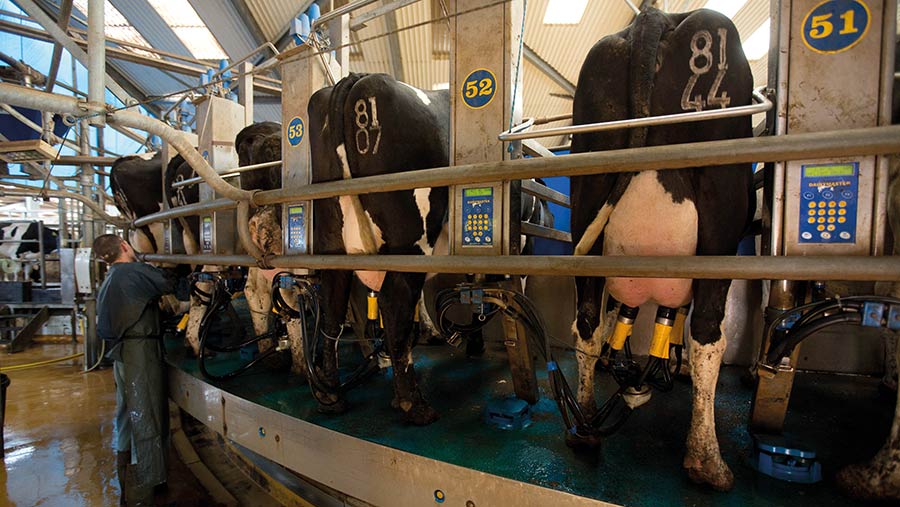How to find and employ apprentices on your dairy farm
 © Tim Scrivener
© Tim Scrivener Employing an apprentice is straightforward, and there is financial support and help available from the various governments in England, Wales, Scotland and Northern Ireland.
People consultant Paul Harris from Real Success outlines his seven top tips for attracting the best candidates for your farm.
The exact rules vary by country, but some principles are consistent:
- Apprentices can be employed at different levels, from school leavers and university graduates to people who want to further their careers or change career direction completely
- An apprenticeship usually takes between two and four years to complete, depending on the type
- You can adapt the training according to the needs of your business, but apprentices must work in a role that is relevant to their apprenticeship
- Apprentices must be 16 or over and not in full-time education.
See also: Overseas staff: Tips to ensure eligibility to work in UK
1. Hiring an apprentice
Most businesses choose an apprenticeship training course and then find a training provider using the various tools available on government websites. You can search for “agriculture” or “farming” to find courses, with contractors or providers also listed.
You must sign an apprenticeship agreement that provides details of the skill or trade the apprentice is being trained for, the name of the apprenticeship they are working towards, the dates of the apprenticeship, and details of the off-the-job training they will receive.
You also need to prepare a commitment statement that sets out how you, your training provider and the apprentice will support the successful achievement of the apprenticeship, including through experience gained on the job.
The apprentice receives their apprenticeship certificate after they have passed the assessments at the end of their study, demonstrating that they are occupationally competent.
2. Finding an apprentice
There are many ways to find an apprentice and increase the diversity of your applicants. For example, you can:
- Advertise on a recruitment website
- Hold open days
- Visit schools, colleges and universities
- Use social media or your own website
- Participate in careers events
- Contact your local careers office
- Contact the national apprenticeship service for your country.
3. What to pay
You must pay the national minimum wages (for the time they work for you) – depending on the year of their apprenticeship.
If they are younger than 19 years or in the first year of their apprenticeship, they are entitled to a minimum hourly rate of £4.30 (from April 2021).
Apprentices are entitled to the national minimum wage for their age if they are aged 19 or over and have completed the first year of their apprenticeship.
National minimum wage rates across the UK |
|||||
|
Age |
23 and over |
21-22 |
18-20 |
Under 18 |
Apprentice |
|
April 2021 |
£8.91 |
£8.36 |
£6.56 |
£4.62 |
£4.30 |
4. Funding an apprentice
Governments provide support for apprenticeship training.
The amount you receive depends on the country in which your business is located and, for England, whether you pay the apprenticeship levy (payable if you have a wages bill of more than £3m/year).
For businesses that don’t pay the apprenticeship levy (likely to be many farming businesses), that also employ fewer than 50 employees, the government will pay 100% of the apprenticeship training costs up to the funding maximum for their age band and type of apprenticeship (often about £5,000 for level 2 apprenticeships).
There are incentives for hiring new apprentices and for those who may have been made redundant. Check with your own government websites for more details.
5. What jobs should they do?
A general farmworker (level 2) apprentice who specialises in livestock would be expected to learn many basic farm tasks, such as identifying hazards and risks in the workplace, maintaining hygiene and biosecurity procedures for the farm, checking that animal welfare needs are being met, assisting with safe moving and handling of livestock and operating farm machinery safely.
Other tasks will depend on the level and type of apprenticeship.
6. What training should we offer?
During their apprenticeship, your apprentice should receive two different types of training:
- Off-the-job training is delivered by a training provider during your apprentice’s normal working hours. This training teaches them the knowledge, skills and behaviours set out in the apprenticeship standard so they can achieve occupational competence. The frequency can include blocks of time, part of a working day, or a specific day in the week. You simply agree to the training schedule with your training provider to suit the needs of your business.
- On-the-job training is delivered by the employer. These will be the key skills to enable the apprentice to perform the job you’ve hired them for. It’s also important to provide correct supervision to ensure that the apprentice is developing in accordance with your apprenticeship agreement and commitment statement.
7. Retaining the apprentice
At the end of the apprenticeship and on successful completion of the end-point assessment, you may wish to retain the apprentice within your team and offer them a full-time position.
You will need to review your levels of pay to ensure you are meeting the minimum wage requirements, and build a career path for them within your ongoing training and development plan.
A clear job description and employment contract are the essential building blocks for a new employee, so treat the apprentice with the same respect and attention as you would any new member of staff.
Paul Harris is managing director of Real Success – a people consultancy that helps the agricultural sector to improve staff management.
A regular speaker at industry events, Mr Harris is widely recognised as a thought leader and positive advocate of staff development in the agricultural sector.
